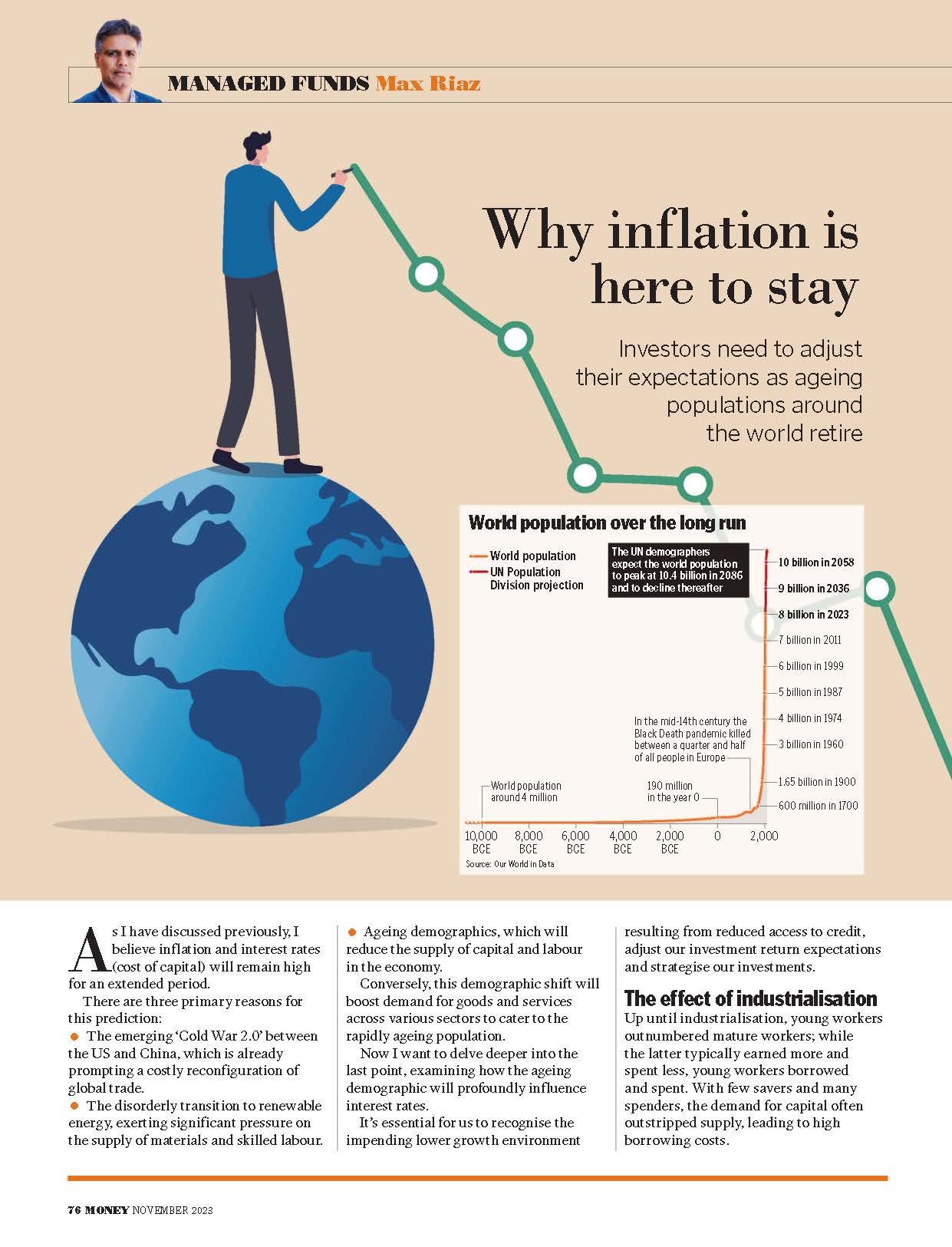Ocado Group Plc - Apple Inc of online grocery retail.
/Ocado Group Plc is a company that our investment management team is particularly excited about. We view the company as Apple Inc. of online grocery retailing because of the way it’s revolutionising grocery retailing online and that too, profitably. We think you may get just as impressed once you have read through this piece and learned some of the nifty ways in which they run their operations. We met with Ocado’s management in London and have done deep-dive research on its business and operations over the past year and a half, we have come away believing that Ocado Group is in a class of its own.
Ocado Group (LSE:OCDO) listed on the London Stock Exchange in July 2010 and has over 15 years of trading history. It is an incredibly long period of survival for a pure-play e-commerce grocery retailer when a commonly held belief is that such companies are not profitable and don’t survive long. Well, Ocado is different. In this note, we will explore some reasons for how it is different. OCDO is a global leader in online grocery retailing with over 600,000 active customers. The Company’s key competitive advantage lies in a unique end-to-end operating solution for online grocery retail based on its proprietary technology and intellectual property (IP). The company has two key operating segments: (1) Retail (online grocery retailing); and (2) Ocado Solutions (licenses out Company’s IP and technology to retailers globally).
Ocado has spent almost the last two decades fine-tuning and improving its operations to a point where it is now a slick and automated order fulfillment and logistics operation with cost efficiency and experience of successfully running a high tech operation being its key points of differentiation. It has built a winning model which is attracting leading bricks and mortar grocery chains from across the world to partner with Ocado and use its know-how in developing their online grocery retailing systems. Coles Group of Australia, Marks & Spencer in the U.K. and Kroger in the U.S. are three examples of recently struck partnerships with Ocado. With Kroger in the U.S. over the coming years, Ocado plans to build a national network of automated warehouses to serve the e-commerce grocery market in the U.S. Coles group expects to do the same in Australia.
Some history
Let’s take a trip down memory lane. Approximately eighteen years ago, long before Ocado became a provider of solutions to other grocery giants, it was created as an e-commerce pure-play in the UK. The concept was to harness the very best technologies available to create a viable and winning economic model for online grocery retailing. Fifteen years ago Ocado opened its first automated warehouse and seven years later it turned a profit. The company is now listed on the London Stock Exchange and its UK online grocery business has revenues of two billion dollars and for every single quarter of the last three years, it has been gaining market share from Tesco, Walmart, Sainsbury’s all of whom have multi-billion dollar online grocery businesses in the UK. Quite a fete as the UK is the most penetrated market for online grocery retailing in the Western world.
Having internally developed and fine-tuned its fully automated order fulfillment system, the company decided to leverage this IP and scale its business globally through a partnership model with large grocery chains. To execute this strategy, the company has created a subsidiary named Ocado Solutions.
Urban myths
Myth #1 Nobody makes money selling food online.
Not true. In the past, there have been failures when physical grocers have attempted to sell groceries online by adding it as a new cost centre without rethinking their fulfillment system from end-to-end. These attempts were failures as prices were kept the same while costs increased by selling online. This was bad economics for what is a low margin business anyway. Ocado has done it differently by thinking end-to-end and has proven that online grocery retailing can be done profitably, it has done so against fierce competition from the top five grocers in the world.
Myth #2 Nobody buys fresh food online.
Not true. Ocado’s fresh food comprises 48% of total sales, which is higher than the national average of grocers in the UK in terms of fresh food participation.
Myth #3 Online grocery shopping is for the millennials.
This is incorrect. In the UK, which is the most penetrated online grocery market, around 50% of households nationally use online grocery from time to time. This trend is taking off in other countries around the globe also. The highest penetrated group are not the millennials but actually the families in the UK.
The US has traditionally had much lower penetration of online grocery retailing than the UK but this is changing quite rapidly and it is expected the US will catch up to the UK. The data shows that there is pent-up demand from consumers for online grocery shopping if they were presented with a compelling proposition.
What exactly is that compelling proposition to woo customers to shop online for their groceries?
Ocado believes it has spent the past eighteen years figuring it out and it has the success to demonstrate what that compelling proposition to consumers looks and feels like. We will discuss that proposition for the remainder of this note. Many online businesses have a compelling position for consumers but don’t make any money. Ocado has been proactive in the sense that its total success is built on two equal foundations, a compelling proposition for consumers and a profitable operation. Need to have both for a sustainable future.
An online grocery retailing operation has two major components. First, it needs to have order fulfillment operation which includes warehousing, picking, packing and dispatch. And second, it needs a delivery or final mile operation which essentially involves delivering the dispatched groceries to the consumer. Ocado had a choice of three main options to choose from when setting up its fulfillment part of the operation, namely:
Dark store – which is essentially a large supermarket not open to the public but only for filling online orders.
Pick in store – here the customer comes to the participating store to collect their order purchased online.
Automated Warehouse – This is the option Ocado chose to develop as part of its fulfillment strategy. Ocado Group Plc owns fully robot-controlled warehouses that can typically span 18 acres. Robots collect groceries from crates beneath them and drop them off at a packing station where robots pack the goods to fulfill individual orders.
In terms of its choices for getting the groceries to customers it makes home deliveries and also has collection sites available for customers who prefer to pick-up. More interestingly it is working on driverless cars and in-car robots to completely automate the delivery process. Which will further take costs outs of its total cost to fulfill orders. This obsession with automation does translate to Ocado being not only profitable but much more cost competitive to its nearest online grocery competitor.
We got some real data from the company on their US business to show the price advantage for consumers buying from Ocado’s online shop versus two other competitors. In the figure below, the left hand column displays pricing to consumers by a physical grocery chain that also sells groceries online. The middle column is an app that sells online through partnerships with physical stores and the right most column shows Ocado Group’s costs and price for delivering a $100 basket of groceries through its vertically integrated model.
Figure: Pricing comparison for home deliveries. Source: Banyantree, Ocado Group
Consumers see these prices and can draw the obvious conclusion that it is costing them $30 extra to have their groceries delivered home through the first option, the middle option they are still paying a hefty $15 but the right most option of only a $2 extra is insignificant. And therein lies why Ocado is such a compelling proposition for consumers.
Price is one aspect of a compelling proposition; the other important aspect is service. With online grocery retailing it is imperative to get the right product, delivered at the right time, at the right location. Ocado achieves 99.7% accuracy in the orders it delivers to customers. Without automation in warehouses it will not be possible to pick and deliver accurately particularly with forty five thousand product types (SKUs), which is a wider product range than offered by competitors.
Three important aspects of a well operating online grocery store include:
A great looking and well-functioning online shop that drives basket build and repeat purchasing;
Rethinking fulfilment in a way that will take cost out of the equation compared to the way grocery shopping is currently done; and
A highly optimised last mile (delivery) system.
Online model allows for faster & efficient iteration
The benefit of having an online grocery model is that you can test and trial new things at a faster pace and iterate to better outcomes whereas in a physical world it takes a lot more adjusting and costs. Ocado is using artificial intelligence in its online shop to drive a better customer experience. For example, AI can learn the consumer patterns from past purchases and improve faster and more efficient search and listing of preferred products for purchasing in online shop.
Ocado has also developed a use-by date box for perishable products giving customers better than in-store experience as the use-by date is indicated online whereas in store sometimes it can be at the back of packaging or on tags that go missing etc. The company also has a first-in-first-out selling process to ensure waste is massively reduced e.g. Ocado’s wastage is 0.7% of total goods sold whereas the industry average is 2-3%. There are also other attractive features of the web shop such as calorie counter for health conscious customers. It tells customers how much calories a certain product has and how long they will need to walk or run to burn it off, but the feature also suggests lower calorie substitute products. Customers love these kinds of features.
Fully automated warehouses
Behind the web-shop are strategically located automated warehouses which are designed entirely from scratch to have fast moving robots picking individual products from 72,000 storage cells that are densely packed together in the warehouse making full use of the available space. The robots move at high speeds around a three dimensional grid and collect to a basket order and pass the basket to packing stations. At packing stations, Robots can pack at 3,500 orders per hour, which is super fast and super-efficient in terms of labour cost savings. These factors make the difference between a profitable and an unprofitable online grocery business. This is one of the key reasons why Kroger in the US and other major retailers are partnering with Ocado to access this IP.
Super efficient logistics system
The delivery system is built on the hub and spoke model. The company owns and controls the delivery system itself and doesn’t outsource to a contracting logistics or transport company. The company wants to ensure its customers experience a branded delivery system as it is at this point the customer is coming into physical contact with the company and it wants to manage the quality of experience to the home. Ocado has been able to fine tune the economics of the delivery system and cover 75% of the UK population from four hub points around the country. Most of the deliveries are done same day and delivery points farthest from the production points receive their delivery the next day. Ocado has one hundred vans at each hub site delivering two thousand orders a day. To run a delivery system at this scale requires a very well run logistics & routing system as the author recalls having worked for a multi-national scale supply chain & logistics operation two decades ago. The challenge of successfully incorporating new orders received during the day into the same day routing plan is truly a fete! The company knows that the value of the business lies in its operations and so it is investing a lot of money in robotics, analytics, AI, and machine learning.
The End.
Note: Please contact our office if you would like to access our research reports on Ocado Group Plc.
A: Level 1, 123 Clarence St., Sydney, NSW, 2000
W: www.banyantreeinvestmentgroup.com
E: info@banyantreeinvestmentgroup.com
P: +61 2 9696 8163
“Banyantree Investment Group produces institutional-quality investment research and recommendations for wealth advisors. We give wealth advisors the confidence to offer their retail clients an internalised and independent investment management capability under their own brand- name by leveraging Banyantree Investment Group’s demonstrable capability, experience and performance.”

































